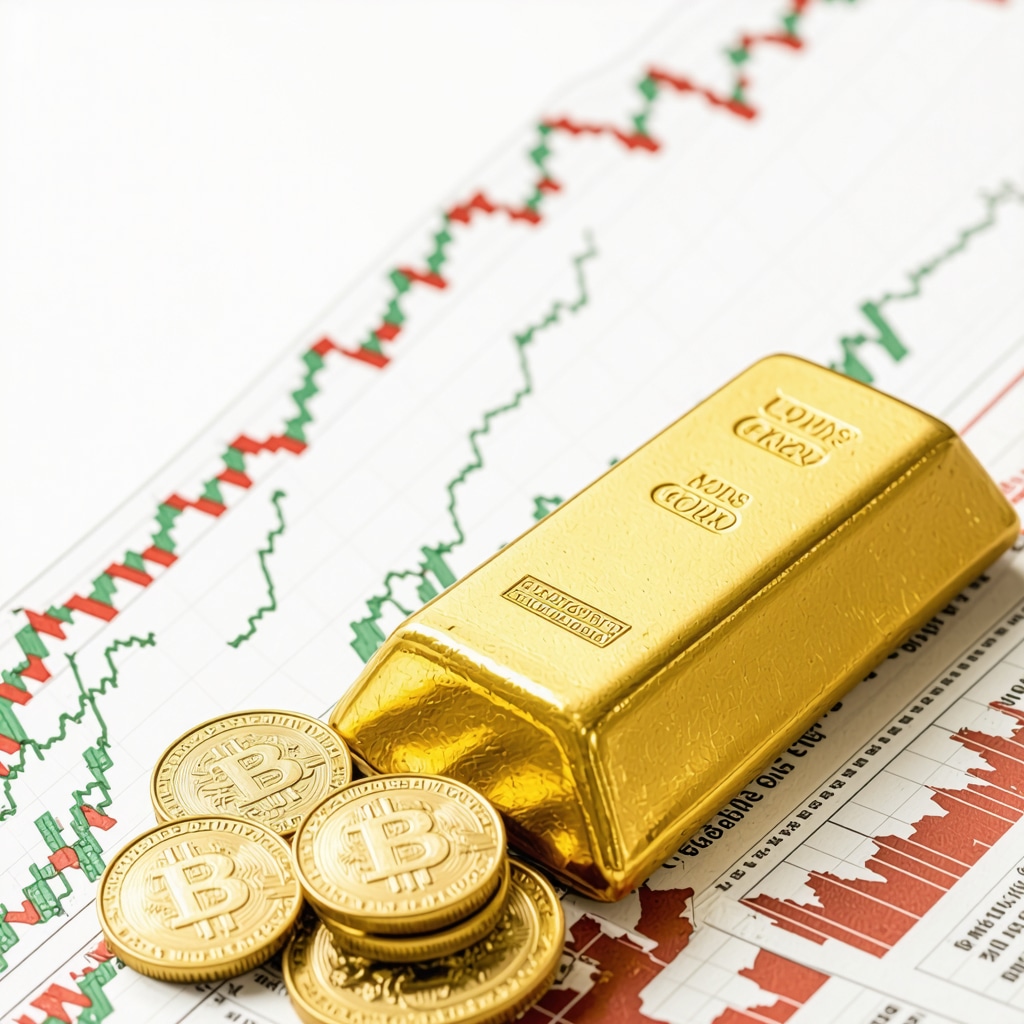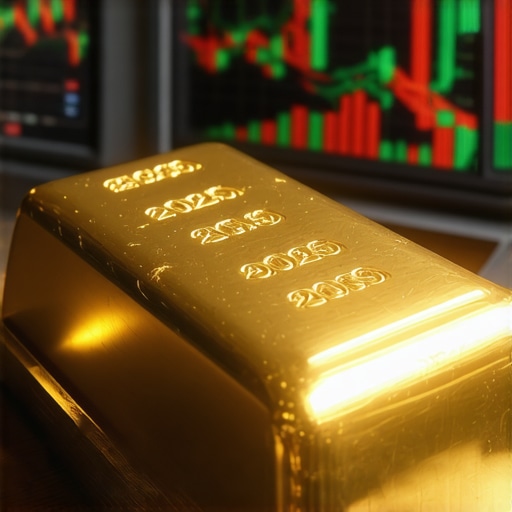My First Encounter with the Gold Market: A Learning Experience
I still remember the first time I seriously considered investing in gold. Like many, I was drawn to its reputation as a safe haven during uncertain economic times. But diving into the gold market without understanding its trends felt like sailing without a compass. I quickly realized that to make better investment decisions, I needed to learn how to analyze gold market trends effectively.
Decoding Gold Price Movements: What I Discovered
One of the first lessons I learned was that gold prices are influenced by a complex mix of factors. Inflation rates, currency fluctuations, geopolitical tensions, and even central bank gold purchases all play crucial roles. I found resources like this detailed guide on gold price trends incredibly helpful to understand these dynamics better. Tracking these indicators over time gave me a clearer picture of when gold might surge or dip.
How Can You Spot Reliable Trends in the Gold Market?
From my experience, spotting reliable trends means combining both technical analysis and fundamental insights. Technical analysis involves looking at price charts and patterns, while fundamental analysis examines economic data and market sentiment. I often check reports on global gold supply and demand, which you can explore more in-depth here. Understanding these trends helped me anticipate market movements rather than reacting blindly.
Why I Trust Central Bank Activity as a Market Indicator
One surprising insight from my journey was the significant impact of central bank gold purchases on price trends. When major banks increase their gold reserves, it often signals confidence in gold’s value, influencing the market positively. I recommend keeping an eye on updates like those shared in this analysis of central bank gold buying to stay ahead of market shifts.
Balancing Intuition and Data: My Personal Strategy
Over time, I’ve learned that while data and trends are vital, trusting your investment intuition also matters. After all, no analysis can guarantee success in a volatile market. I combine my research with a diversified approach, including physical gold, ETFs, and mutual funds, to manage risk better. If you want to explore diversification, check out my thoughts on gold ETFs and mutual funds.
I’d love to hear about your experiences with analyzing gold market trends or any questions you have. Feel free to share your thoughts in the comments below – learning together makes us all better investors.
For those interested in a broader economic perspective, the World Gold Council offers authoritative insights into gold market dynamics, which I often consult to inform my decisions (gold.org).
Incorporating Geopolitical Events into Your Gold Trend Analysis
One aspect that I found increasingly important as I refined my approach was the influence of geopolitical events on gold prices. Sudden political unrest, trade tensions, and international conflicts often trigger spikes in gold demand as investors seek stability. A nuanced understanding of these events allows you to anticipate short-term volatility and adjust your holdings accordingly. For instance, watching developments in major economies or regions known to impact global markets can provide early signals for gold price movements. This complements the technical and fundamental analyses I mentioned earlier, offering a more holistic market perspective.
How Do Supply Constraints Affect Gold’s Price Trajectory?
Supply-side dynamics are often underestimated in casual analysis but are critical to understanding gold’s price behavior. Factors such as mining output limitations, regulatory changes, and disruptions in key producing countries can restrict supply, thereby pushing prices higher. I recommend following detailed reports on global gold supply and demand trends, like the in-depth analysis available here, to grasp these nuances. For example, a slowdown in mining production due to labor strikes or environmental restrictions can have a ripple effect on market sentiment and prices.
What Are the Practical Steps to Integrate Market Sentiment into Your Gold Investment Strategy?
Market sentiment is a subtle yet powerful driver of price movement, often reflecting collective investor psychology more than hard data. To integrate sentiment analysis effectively, I track gold-related news, social media trends, and institutional investor reports. Tools like the Commitment of Traders (COT) reports provide insights into how large speculators and commercial traders position themselves in the market, which can foreshadow price shifts. Combining sentiment with fundamental and technical data enhances decision-making precision. For those interested in developing a rounded strategy, resources such as effective gold investment strategies to hedge inflation offer practical guidance.
According to the World Gold Council, understanding the interplay between geopolitical tensions, supply constraints, and investor sentiment is essential for navigating the gold market in 2025 and beyond (gold.org research).
If you have insights or questions about incorporating these advanced factors into your gold market analysis, please share your thoughts in the comments. Discussing diverse perspectives enriches our collective expertise.
When Market Noise Clouds Judgment: Lessons from Volatile Periods
Reflecting on my journey, one of the trickiest phases was navigating gold price volatility during global crises. The rapid ups and downs can feel like a storm tossing your investment ship wildly. I learned that during such periods, patience and a steady analytical framework become invaluable. Instead of reacting impulsively to headline-driven spikes, I began focusing on underlying supply-demand fundamentals and longer-term trend patterns, which you can explore in depth here. This approach helped me avoid common pitfalls many investors fall into when market sentiment runs high.
How Do You Balance Short-Term Volatility with Long-Term Investment Goals?
This question often comes up in discussions with fellow investors. From my experience, the key is defining your investment horizon clearly. If you’re investing for retirement or wealth preservation, short-term price fluctuations become less relevant compared to the broader trend. I personally set aside a portion of my portfolio for tactical moves during volatile spikes but keep the majority in steady, diversified holdings like physical gold bars or ETFs, which you can learn more about in this guide on ETF portfolios. This dual strategy allows me to capitalize on opportunities without jeopardizing my core investment thesis.
Understanding the Role of Emerging Markets in Gold Demand Growth
Another layer of complexity I encountered was how emerging economies influence global gold demand. Rising wealth in countries like India and China not only drives jewelry and investment demand but also shapes price dynamics globally. Watching these markets closely gave me a more nuanced appreciation for demand-side factors beyond traditional Western-centric views. For those interested, this article on global demand trends provides excellent insights. Incorporating these perspectives helped me adjust my timing and positioning, especially during cultural festivals and economic policy shifts in these regions.
Incorporating such diverse factors can feel overwhelming, but I found that keeping a curated watchlist of reliable news sources and reports, like those from the World Gold Council (gold.org), helps maintain clarity amidst complexity.
Personal Reflections on Choosing Physical Gold: Bars vs. Coins
One of the more tactile lessons was my decision between physical gold bars and coins. Each has its unique advantages and challenges. Bars often offer lower premiums over spot price and are easier to store in bulk, while coins provide liquidity and sometimes collectible value. I explored this topic extensively and found this resource on choosing gold coins versus bars particularly enlightening. Personally, I maintain a mix depending on my liquidity needs and storage capabilities. This balance adds flexibility and helps me adapt to both market conditions and personal circumstances.
How have you approached the physical gold versus paper gold debate? I invite you to share your stories or questions in the comments below—your insights might spark new ideas and help others refine their strategies.
Integrating Macro-Economic Indicators to Sharpen Gold Market Forecasts
As my experience with gold investing deepened, I realized the indispensable value of macro-economic indicators beyond just inflation and currency movements. Indicators such as real interest rates, bond yields, and fiscal policies have nuanced effects on gold price trajectories. For example, when real interest rates dip into negative territory, gold often becomes more attractive as a non-yielding asset, driving prices higher. Conversely, rising bond yields can dampen gold’s appeal. I often cross-reference these indicators alongside central bank activities and supply-demand dynamics to refine my forecasts more precisely. For those interested in detailed data and expert analyses, the World Gold Council’s research hub (gold.org research) remains an authoritative resource that I frequently consult to stay updated on these complex interrelations.
How Can Advanced Technical Indicators Enhance Timing in Gold Trading?
One frequently asked question among seasoned investors is how to leverage advanced technical tools to improve entry and exit points in gold trading. Beyond the common moving averages and RSI, I’ve found value in indicators like the Ichimoku Cloud and Fibonacci retracements, which help visualize support and resistance zones amid volatile markets. Integrating volume profile and open interest from futures markets also provides additional context on market sentiment shifts. Combining these with fundamental insights creates a layered approach that increases confidence in timing trades, especially when reacting to geopolitical shocks or central bank announcements. For those wanting to dive deeper into sophisticated trading techniques, this guide on gold trading techniques offers practical step-by-step strategies that have refined my own approach over time.
Personal Lessons on Risk Management: Avoiding Overexposure in a Volatile Market
One of the toughest lessons I learned was managing risk effectively amidst gold’s inherent volatility. It’s tempting to chase sharp upward trends or panic during sudden dips, but safeguarding capital requires disciplined position sizing and clear stop-loss parameters. I now diversify my gold exposure across physical bullion, ETFs, and mining stocks to mitigate specific risks tied to each asset type. Additionally, I routinely reassess my portfolio’s correlation with broader equity and bond markets to avoid unintended concentration. This holistic risk management framework has been crucial, especially when navigating unpredictable geopolitical events or unexpected shifts in monetary policy.
Curious about practical risk control methods and how to balance your gold holdings? I encourage you to explore my detailed thoughts on gold ETFs and mutual funds as part of a diversified investment strategy.
I’m eager to hear your advanced insights or questions about integrating these complex factors into your gold investment approach. Please share your perspectives in the comments below — our collective dialogue sharpens our expertise and navigational skills in this intricate market.
Things I Wish I Knew Earlier (or You Might Find Surprising)
The Power of Patience Over Panic
Early on, I often got caught in the whirlwind of sudden gold price swings, reacting impulsively to headlines or market noise. What I wish I knew sooner is how crucial patience is—waiting for clear trend confirmations rather than chasing every spike or dip. This mindset shift saved me from costly mistakes and helped me focus on long-term fundamentals rather than short-lived volatility.
Not All Gold Is Created Equal
Understanding the difference between physical gold bars, coins, ETFs, and mining stocks was eye-opening. Each has its unique risk-return profile, liquidity, and storage considerations. For example, I used to favor coins for flexibility but learned that bars often provide better value for bulk holdings. Balancing these options, as I discuss in my guide on gold coins versus bars, gave me more control over my portfolio.
Central Banks Are Market Movers, Not Just Background Players
At first, I underestimated how central bank gold purchases influence price trends. Tracking these activities, like in the central bank gold buying analysis, revealed patterns that often preceded major market shifts. It’s like having a sneak peek into institutional confidence in gold’s value.
Geopolitical Events Can Be Both Catalyst and Confounder
While geopolitical tensions often drive gold demand spikes, I learned that not every event translates directly to price movement. The market’s reaction depends on the event’s scale, duration, and investor sentiment. So, blending geopolitical awareness with solid technical and fundamental analysis helps avoid overreacting to headline noise.
Supply Constraints Are Subtle But Significant
Mining disruptions or regulatory changes might seem minor individually but can collectively tighten gold supply and push prices higher. Following detailed reports on global supply-demand trends, like those shared here, helped me anticipate shifts that aren’t always obvious at first glance.
Market Sentiment Is a Quiet Influencer
Beyond charts and data, the mood of investors shapes price action in ways I didn’t fully appreciate until I tracked indicators like the Commitment of Traders reports and social media buzz. Combining sentiment with other analyses made my timing more nuanced, a strategy I outline in my thoughts on effective gold investment strategies.
Resources I’ve Come to Trust Over Time
The World Gold Council (gold.org): Their extensive research and up-to-date market insights have been my go-to for understanding complex global trends and economic impacts on gold. I often recommend it to friends starting their gold journey.
BuyingGoldNow.com Guides: From explaining gold price trends to physical gold investment tips, these resources have helped me sharpen both my technical and practical understanding with clear, actionable advice.
Commitment of Traders Reports: Tracking these reports gave me a window into institutional positioning and market sentiment, which often precedes price moves. Although a bit technical at first, they’re invaluable once you get the hang of them.
Trusted Financial News Outlets: Keeping an eye on geopolitical developments and economic indicators through reliable news sources helps me contextualize sudden market moves and avoid knee-jerk reactions.
Specialized Trading Guides: For those interested in more advanced techniques, guides like the 2025 gold trading techniques guide have been instrumental in refining my timing strategies.
Parting Thoughts from My Perspective
Analyzing gold market trends is a rich, layered journey that blends data, intuition, and ongoing learning. My biggest takeaway is that no single factor tells the whole story. It’s the interplay of supply-demand dynamics, geopolitical events, central bank actions, and market sentiment that paints the clearest picture. Embracing this complexity with patience and a flexible approach has transformed how I view gold investing.
If you’re stepping into analyzing gold market trends, remember that steady research combined with listening to your instincts can go a long way. I encourage you to explore the resources I’ve shared here and build a strategy that fits your goals and comfort level.
If this resonated with you, I’d love to hear your thoughts or experiences. Feel free to share them in the comments below — after all, we learn best when we learn together.










